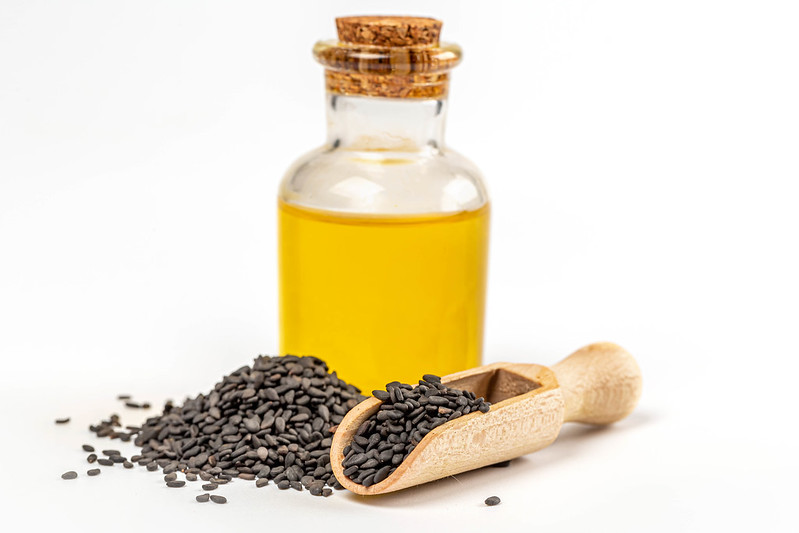The key difference between gingelly oil and sesame oil is that gingelly oil is extracted at a higher temperature, whereas sesame oil is extracted through the cold extraction process. Both gingelly oil and sesame oil are manufactured from the same parent seed, Sesamum Indicum. In fact, there are three variants in the oil taken from sesame seeds. These three variants are due to the difference in the extraction process. They are sesame oil, gingelly oil, and dark brown sesame oil. Dark brown sesame oil is used as a dressing oil to enhance flavour.
Key Takeaways
- Gingelly oil is extracted at a higher temperature, resulting in an amber color and a low smoking point, while sesame oil is extracted through the cold extraction process, resulting in a pale yellow color and a high smoking point.
- Both oils are beneficial for hair and skin health, but they have different uses and flavors in cooking due to their differences in extraction methods and smoking points.
- There are various types of gingelly oil, such as refined, unrefined, organic, and toasted, each with its own unique characteristics and benefits.
What is Gingelly Oil?
Gingelly oil is Indian sesame oil. It is also known as til oil. It is extracted from raw sesame seeds at high temperatures and therefore is amber in colour. This oil consists of vitamin E, phytosterols, lignans, sesamol, and zinc. It is identified as a healthy oil that strengthens, moistures, and smoothens hair. It also cures baldness and removes spots of discolouration. It also has many health effects on the body. The sesamol in gingelly oil is a strong antioxidant, and they help to fight the toxins in the human body. Additionally, the anti-inflammatory properties of this oil protect us from harmful UV rays.
Since gingelly oil has a low smoking point, it is good for salad dressing, marinating, stir-frying, and shallow frying. Moreover, its flavours can be best taken when it is added to food near the end of the cooking process.
There are various types of gingelly oil as refined, unrefined, organic, and toasted. The refined variant has a mild flavour and a high smoke point. The unrefined variant has a nutty flavour and is rich in magnesium, calcium, copper, and vitamin B6. The organic gingerly oil, which is the most expensive variant, is taken from organically cultivated sesame seeds, whereas the toasted variant, which is dark gingelly oil, has a strong nutty flavour and is taken from toasted sesame seeds.
What is Sesame Oil?
Sesame oil is edible vegetable oil. It is taken from raw sesame seeds using cold-pressed or non-cold-pressed methods. It has a smoke point of 450F. Sesame oil is one of the earliest crop-based oils. It has oleic acid, linoleic acid, stearic acid and palmitic acid. However, the main ingredient of this oil is vitamin K.
Light sesame oil, which is also known as plain or white sesame oil, is usually used as a neutral cooking oil, whereas toasted sesame oil, which is darker and stronger in flavour, is used in flavouring various types of dishes.
Sesame oil is also good for hair and scalp nourishment and skin. It is capable of protecting the skin from harmful UV rays. However, before applying this to your skin, you have to do a patch test.
What is the Difference Between Gingelly Oil and Sesame Oil?
The key difference between gingelly oil and sesame oil is that gingelly oil is extracted at a higher temperature while sesame oil is extracted through the cold extraction process. While gingelly oil has a low smoking point, sesame oil has a high smoking point.
Summary – Gingelly Oil vs Sesame Oil
Gingelly oil is Indian sesame oil. It is extracted using a high temperature, and therefore it is amber in colour and has a low smoking point. Sesame oil is edible vegetable oil. It is extracted through the cold-pressed method, and this is pale yellow. It has a high smoking point and is therefore used in deep frying. Thus, this is the summary of the difference between gingelly oil and sesame oil. Both these oils are high in calorie content, so you have to be careful not to consume more than necessary.
Reference:
1. “10 Amazing Health Benefits Of Switching To Gingelly Oil.” B & B Organics.
2. “Sesame Oil.” Wikipedia. Wikipedia Foundation.
Image Courtesy:1. “Sesame oil in glass bottle with black sesame seed in wooden scoop on white” By Marco Verch Professional Photography (CC BY 2.0) via Flickr
Related posts:
